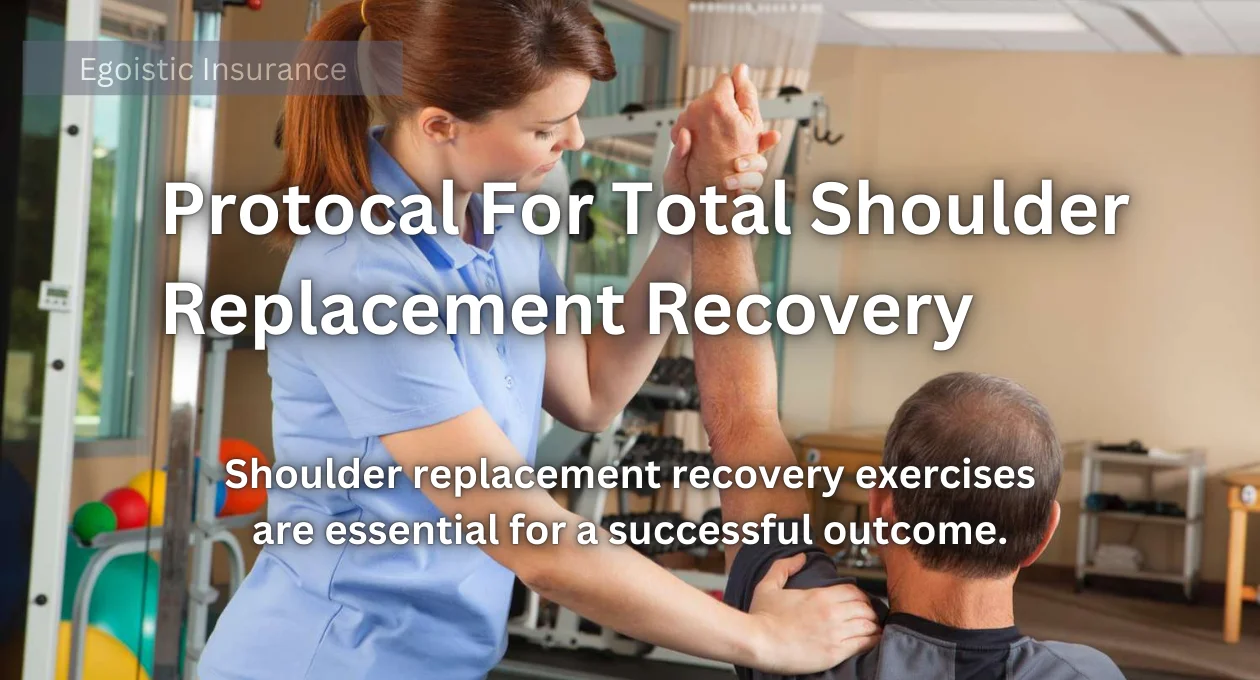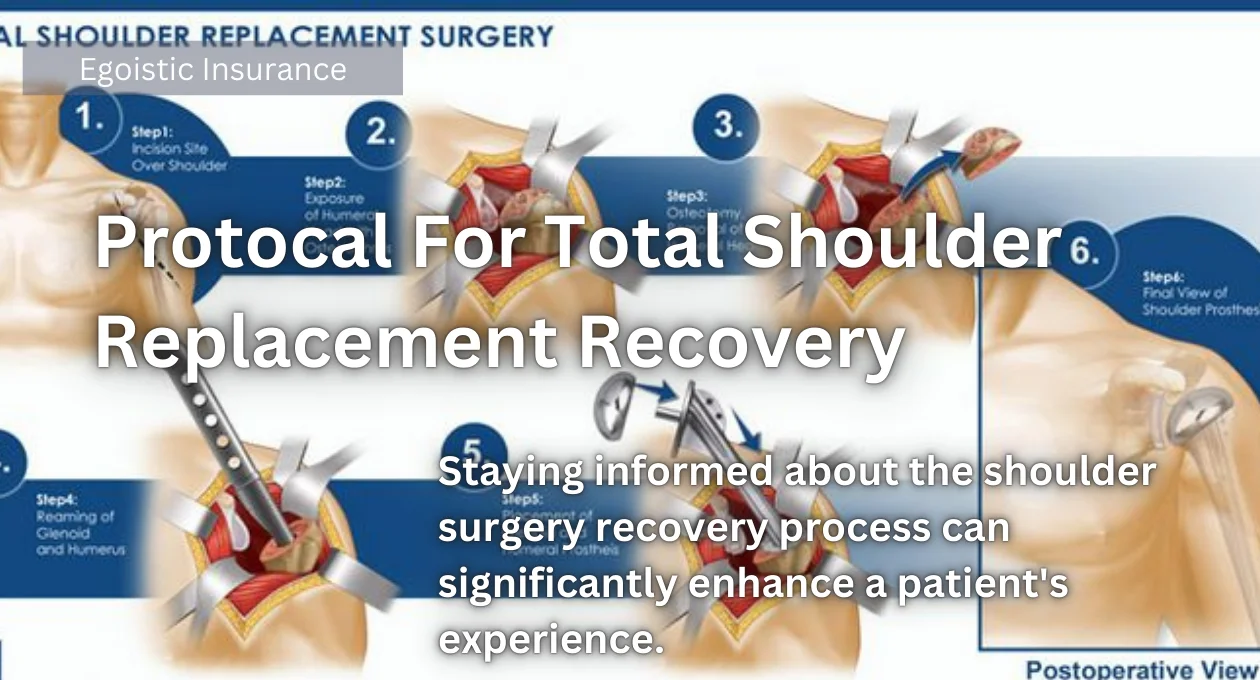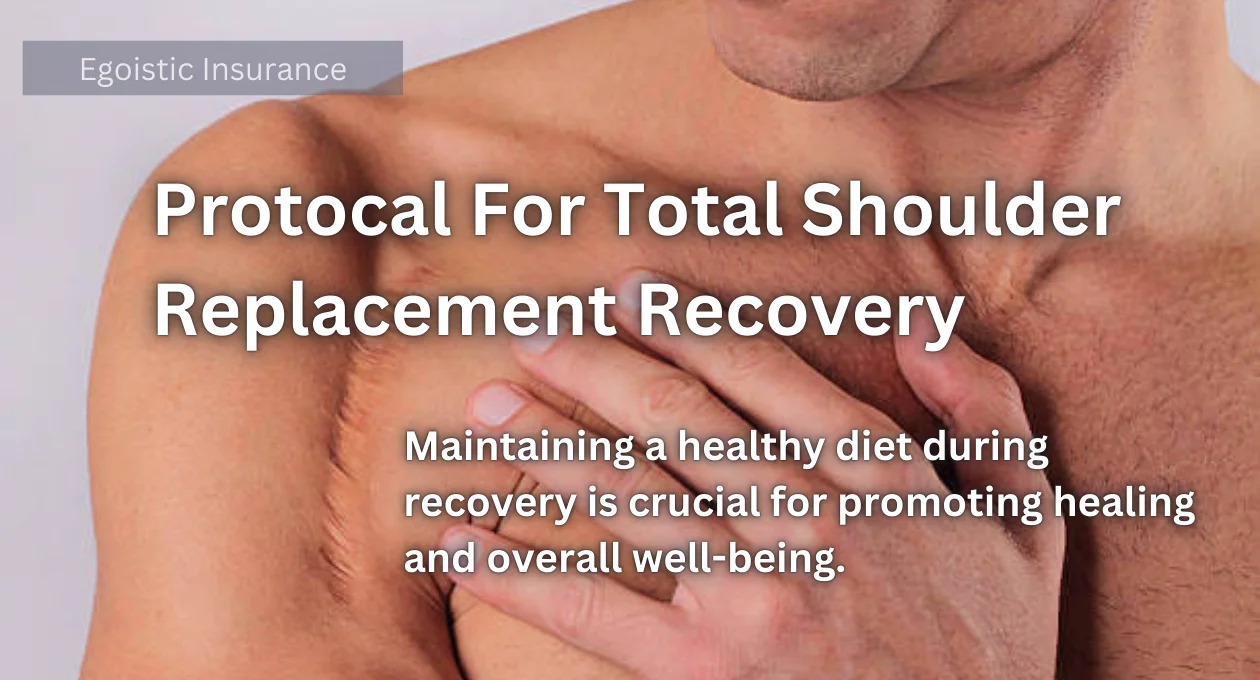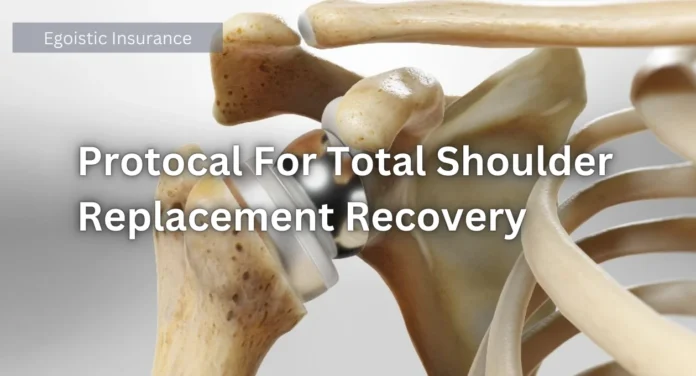Protocol for Total Shoulder Replacement Recovery is the total shoulder replacement (TSR), also known as total shoulder arthroplasty, is a significant surgical procedure designed to alleviate pain and restore function to a severely damaged shoulder joint. Recovery from this surgery requires a carefully structured rehabilitation protocol to ensure the best outcomes. This blog will cover various aspects of recovery, including timelines, physical therapy, exercises, and pain management.
The initial phase of recovery typically begins in the hospital, where patients are closely monitored for any complications. Within the first few days, pain management is critical, and medications may be administered to help alleviate discomfort. During this time, patients are encouraged to perform gentle movements as advised by their healthcare team to prevent stiffness. Following discharge, a structured physical therapy program will be initiated to support healing and restore mobility.
Post-Shoulder Surgery Rehabilitation
Rehabilitation after total shoulder replacement is crucial for regaining strength, mobility, and function in the shoulder joint. The post-shoulder surgery rehabilitation process typically begins immediately after the procedure and involves a series of steps designed to promote healing and recovery. This phase includes managing pain, protecting the surgical site, and gradually increasing shoulder movement and strength.
During the early stages of rehabilitation, it’s essential to follow the prescribed physical therapy regimen closely. This often includes passive range of motion exercises, which help to gently mobilize the shoulder without straining the surgical site. Patients may also be instructed to wear a sling for support, allowing the joint to heal while maintaining some movement. Consistency in attending therapy sessions and performing at-home exercises will significantly contribute to a successful recovery.
Shoulder Replacement Recovery Timeline
The shoulder replacement recovery timeline can vary significantly based on individual factors such as age, overall health, and adherence to rehabilitation protocols. Generally, patients can expect to begin gentle shoulder movements within the first few weeks post-surgery. As healing progresses, more active exercises will be introduced to build strength and improve range of motion. By the three to six-month mark, many individuals may return to normal daily activities, although high-impact sports and heavy lifting may require additional time for safe resumption. The shoulder replacement recovery timeline can vary from patient to patient, but a general outline is as follows:
- Immediate Postoperative Phase (0-2 weeks): Focuses on pain management, reducing swelling, and protecting the shoulder with a sling.
- Early Rehabilitation Phase (2-6 weeks): Includes gentle range-of-motion exercises and physical therapy to start restoring movement.
- Intermediate Phase (6-12 weeks): Intensifies physical therapy with strengthening exercises and more active movement.
- Late Rehabilitation Phase (3-6 months): Emphasizes functional strength and endurance, with a gradual return to normal activities.
- Long-Term Recovery (6 months and beyond): Continuous improvement in strength and mobility, with an ongoing exercise regimen.
Physical Therapy After Shoulder Replacement
Physical therapy is a cornerstone of shoulder replacement recovery.
Physical therapy not only aids in pain management but also plays a vital role in enhancing joint functionality. Therapeutic exercises, guided by a licensed physical therapist, are tailored to the individual’s needs and progress throughout the recovery journey. Patients are often encouraged to engage in both in-clinic sessions and at-home exercises to optimally support their healing. This dual approach ensures a comprehensive recovery, allowing patients to regain independence and return to their desired lifestyle.
It helps to:
- Restore Range of Motion: Early therapy focuses on gentle exercises to prevent stiffness.
- Strengthen Muscles: Gradual introduction of resistance exercises to rebuild muscle strength.
- Improve Function: Therapy sessions aim to improve daily activities and shoulder function.
Shoulder Replacement Recovery Exercises

Shoulder replacement recovery exercises are essential for a successful outcome. These exercises should begin with gentle range of motion activities aimed at preventing stiffness and promoting circulation in the shoulder joint. As recovery progresses, patients can gradually incorporate more strengthening exercises that focus on the rotator cuff and scapular muscles. Consistency in performing these exercises is crucial, as they help to restore function and support a return to normal daily activities. Always consult with a physical therapist to ensure that exercises are performed safely and effectively.
They are typically categorized into:
- Range-of-Motion Exercises: These are initiated early to prevent stiffness and improve mobility.
- Strengthening Exercises: Introduced after the initial healing phase to build muscle strength around the shoulder.
- Functional Exercises: Designed to mimic everyday activities to help integrate the shoulder back into normal life.
Shoulder Surgery Recovery Protocol
Adhering to a structured shoulder surgery recovery protocol is essential for maximising outcomes and ensuring a smooth rehabilitation journey. This protocol typically includes a combination of scheduled physical therapy sessions, at-home exercises, and regular check-ins with healthcare providers to monitor progress. Patients are encouraged to maintain a routine that balances rest with activity, adhering to their therapist’s guidance on when to increase intensity. Keeping a positive attitude and setting realistic recovery goals can also enhance motivation and foster resilience throughout the recovery process.
A comprehensive shoulder surgery recovery protocol includes:
- Pain Management: Using medications and techniques to control postoperative pain.
- Wound Care: Keeping the surgical site clean and dry to prevent infection.
- Activity Restrictions: Adhering to guidelines to avoid stressing the shoulder prematurely.
- Scheduled Follow-ups: Regular check-ups with your surgeon to monitor healing progress.
Total Shoulder Arthroplasty Rehabilitation
Total shoulder arthroplasty rehabilitation is a critical phase where patients work closely with their healthcare team to optimise recovery outcomes. This period focuses on restoring function and mobility while managing any discomfort following surgery. Adapting exercises to match individual progress ensures that patients can regain strength without risking injury. Establishing clear communication with therapists and healthcare providers is vital, as it fosters a supportive environment for achieving rehabilitation goals.
Rehabilitation following total shoulder arthroplasty (TSA) is a structured process involving:
- Initial Immobilization: Using a sling to support the shoulder and minimize movement.
- Progressive Mobilization: Gradual introduction of exercises to improve range of motion and strength.
- Ongoing Therapy: Continued physical therapy sessions to ensure comprehensive recovery.
Shoulder Replacement Pain Management

Effective pain management is crucial during the shoulder replacement recovery process. Patients may be prescribed a combination of medications, including opioids for acute pain relief and nonsteroidal anti-inflammatory drugs (NSAIDs) to manage inflammation. Additionally, complementary therapies such as ice application and guided relaxation techniques can enhance comfort. Close communication with healthcare providers allows for timely adjustments to pain management plans, ensuring patients remain as comfortable as possible throughout their rehabilitation journey.
Sustaining motivation during the recovery process can be challenging, but setting small, achievable goals can significantly enhance one’s progress. Tracking improvements, no matter how minor, helps to foster a sense of accomplishment and encourages persistence. Engaging with support groups or recovery communities can provide additional encouragement as individuals share their experiences and celebrate milestones together. Remember, every step taken in rehabilitation brings one closer to regaining full functionality and returning to an active lifestyle.
Effective pain management is vital for a smooth recovery. Strategies may include:
- Medications: Pain relievers and anti-inflammatory drugs prescribed by your surgeon.
- Ice Therapy: Applying ice packs to reduce swelling and numb the area.
- Elevation: Keeping the shoulder elevated to minimize swelling.
Postoperative Shoulder Care
Postoperative shoulder care plays a crucial role in ensuring optimal recovery after surgery. Patients should be vigilant about keeping the surgical site clean and observing any signs of infection, such as increased redness or discharge. Regularly following the recommended exercises, even when feeling discomfort, can aid in the healing process and restore mobility. Continued communication with healthcare professionals is essential to address any concerns and make necessary adjustments to the recovery plan.
Proper postoperative shoulder care includes:
- Sling Usage: Wearing the sling as directed to protect the shoulder.
- Wound Monitoring: Watching for signs of infection or complications.
- Gentle Movement: Performing prescribed exercises to maintain flexibility and prevent stiffness.
Shoulder Surgery Recovery Tips

Staying informed about the shoulder surgery recovery process can significantly enhance a patient’s experience. Understanding each phase of recovery allows individuals to set realistic expectations and prepare mentally for the journey ahead. Engaging in open discussions with healthcare providers and asking questions will empower patients and help them navigate challenges effectively. Additionally, cultivating patience and resilience during rehabilitation can lead to successful outcomes and a quicker return to normal activities.
To enhance your recovery, consider the following tips:
- Follow Instructions: Adhere to your surgeon’s and therapist’s guidelines.
- Stay Active: Engage in light, recommended activities to promote healing.
- Communicate: Keep your healthcare team informed about any issues or concerns.
Shoulder Replacement Mobility Exercises
Incorporating mobility exercises into the recovery plan is essential for regaining strength and function in the shoulder. Patients should focus on gentle stretches and movements that promote flexibility without causing excessive strain. Consistency in practicing these exercises will contribute to improved range of motion over time, making daily activities more manageable. It’s important for individuals to listen to their bodies and consult with their healthcare team to ensure they are progressing safely throughout their rehabilitation journey.
Mobility exercises are critical in the early stages of recovery. These exercises typically involve:
- Pendulum Swings: Gently swinging the arm to improve range of motion.
- Passive Range-of-Motion: Using the unaffected arm or a therapist to move the affected shoulder.
Rehabilitation After Total Shoulder Arthroplasty
During the recovery process, it’s essential to maintain a positive mindset and foster a supportive network. Engaging family and friends can provide the emotional boost needed to overcome challenges. Incorporate relaxation techniques such as deep breathing or meditation to help manage stress and enhance overall well-being. Remember, each small step forward is a significant achievement on the road to recovery. Effective rehabilitation after total shoulder arthroplasty involves:
- Early Engagement: Starting physical therapy soon after surgery.
- Personalized Programs: Tailoring the rehabilitation program to individual needs and progress.
- Regular Assessments: Frequent evaluations to adjust the therapy plan as needed.
Shoulder Replacement Recovery Stages
Recovery from shoulder replacement surgery is a gradual process that varies for each individual. Patients often experience phases of improvement and occasional setbacks, making it essential to remain patient and positive. Establishing a consistent routine for exercises and adhering to medical advice will foster steady progress. Staying connected with healthcare practitioners ensures that any concerns are addressed promptly, enabling a smoother path to recovery. The recovery stages after shoulder replacement include:
- Acute Phase: Focused on pain control and initial healing.
- Early Recovery: Involves beginning physical therapy and gentle exercises.
- Strengthening Phase: Emphasizes muscle strengthening and functional improvements.
- Full Recovery: Achieving normal shoulder function and resuming daily activities.
Best Practices for Shoulder Replacement Recovery

Maintaining a healthy diet during recovery is crucial for promoting healing and overall well-being. Nutrient-rich foods can aid in tissue repair and reduce inflammation, making it important to include ample fruits, vegetables, lean proteins, and whole grains in daily meals. Staying hydrated is equally essential, as proper fluid intake supports bodily functions and enhances recovery. Additionally, consider discussing dietary plans with a healthcare professional to ensure nutritional needs are effectively met throughout the rehabilitation process.
To optimize your shoulder replacement recovery, follow these best practices:
- Adhere to the Rehabilitation Plan: Consistency in following the prescribed exercises and therapy is crucial.
- Maintain a Healthy Lifestyle: Good nutrition and overall health contribute to better healing.
- Stay Positive and Patient: Recovery takes time, and a positive mindset can aid in the process.
In conclusion, adhering to a well-structured protocol for total shoulder replacement recovery is essential for a successful outcome. By understanding and following these guidelines, including the recovery timeline, physical therapy, exercises, and pain management, you can significantly improve your chances of regaining full shoulder function and returning to your normal activities.
FAQs
What should I expect immediately after shoulder replacement surgery?
Immediately after surgery, you can expect some pain and discomfort, which will be managed with medication. You will also likely have a temporary immobiliser or sling to protect your shoulder during the initial healing phase. Your healthcare team will provide you with instructions on how to care for your incision and manage pain.
How long will the recovery process take?
The recovery timeline varies by individual, but most patients can expect to spend several weeks in the early recovery phase, followed by months of rehabilitation. Full recovery and the return to normal activities may take anywhere from three to six months or longer, depending on the extent of the surgery and adherence to the rehabilitation plan.
Can I drive after shoulder replacement surgery?
Driving will depend on your individual progress and the guidelines provided by your surgeon. Generally, patients are advised to wait until they have regained sufficient strength, mobility, and reaction time in their shoulder, which may take several weeks.
When can I return to normal activities?
While the timeline for returning to normal activities varies, many patients can gradually resume everyday tasks within a few weeks. More strenuous activities or sports may take several months, and it’s crucial to discuss your specific goals with your healthcare provider to receive tailored advice.
Are there any activities I should avoid during recovery?
Yes, it’s essential to avoid activities that place excessive strain on your shoulder, such as lifting heavy objects, reaching overhead, or participating in high-impact sports, until you have received clearance from your healthcare provider. Always listen to your body and consult your healthcare team regarding specific concerns.
Conclusion
In summary, recovery from total shoulder arthroplasty is a multifaceted journey that necessitates patience, dedication, and support. By actively participating in a personalized rehabilitation plan, maintaining a nutritious diet, and fostering a positive mindset, patients can significantly enhance their recovery process. Understanding the various stages of recovery and adhering to best practices will not only facilitate healing but also empower individuals to regain full shoulder function and return to a fulfilling life. Remember, each step taken in this journey is a testament to resilience and progress, paving the way for a successful recovery.
Incorporating regular physical activity into your recovery routine can further enhance your overall progress. Gentle activities like walking or light stretching can improve circulation and promote healing. It’s essential to listen to your body and only engage in exercises that feel comfortable and safe. Consulting with your physical therapist can provide guidance on suitable activities that align with your recovery goals.
For more interesting information keep visiting egoisticinsurance.online


